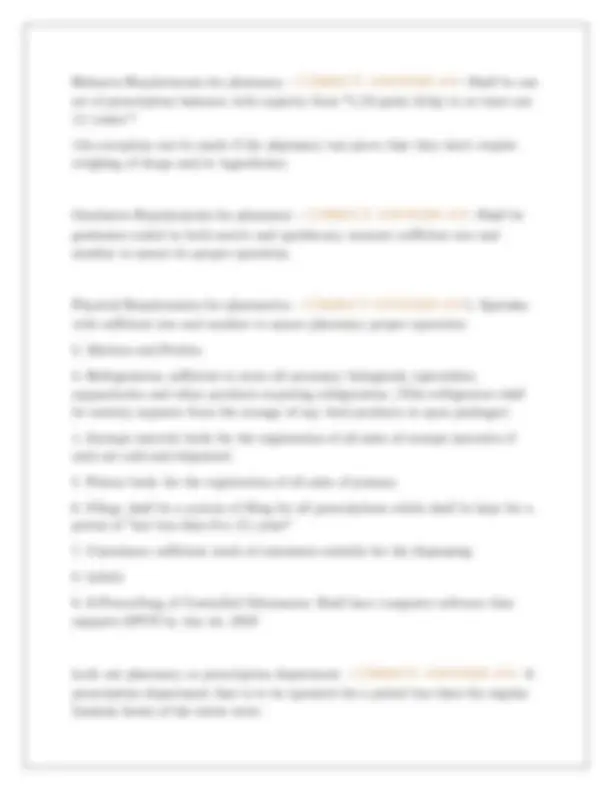


























Study with the several resources on Docsity

Earn points by helping other students or get them with a premium plan


Prepare for your exams
Study with the several resources on Docsity

Earn points to download
Earn points by helping other students or get them with a premium plan
Community
Ask the community for help and clear up your study doubts
Discover the best universities in your country according to Docsity users
Free resources
Download our free guides on studying techniques, anxiety management strategies, and thesis advice from Docsity tutors
A comprehensive overview of the drug approval process, covering pre-clinical testing, clinical trial phases, post-marketing surveillance, and regulatory requirements. It includes detailed explanations of key concepts such as ind, nda, bla, and otc monograph approval process. The document also features a series of questions and answers, designed to test understanding and reinforce learning.
Typology: Exams
1 / 32

This page cannot be seen from the preview
Don't miss anything!

























Pre-clinical (Is it safe?) - CORRECT ANSWERS ✔✔- Drug safety testing on animal (Manufacturer can only file an investigational new drug (IND) to FDA for permission to begin clinical studies phase I if the pre-clinical animal research appears to indicate a relatively safe drug with a potential therapeutic use.) Phase I Clinical Trial (Is it safe for human?) - CORRECT ANSWERS ✔✔- Study on small number of healthy subjects (20-80) to determine if drug is safe.
What does the manufacturer have to do before Phase IV clinical study after the Phase III study showed promising result? - CORRECT ANSWERS ✔✔- They need to submit New Drug Application (NDA) for drug OR Biologics License Application (BLA) for biologics to FDA.
OTC monograph approval process - CORRECT ANSWERS ✔✔- It has three steps which the FDA calls a "three-phase public rulemaking process"
Third Phase of OTC monograph (Final Phase) - CORRECT ANSWERS ✔✔- The publication of the final OTC drug monograph.
Hatch-Waxman Act of 1984 (Drug Price Competition and Patent Term Restoration Act) - CORRECT ANSWERS ✔✔- Purpose: Increase the availability of generics and cut costs for the patient and the healthcare system.
T/F: All licensed pharmacy interns shall notify the Board of Pharmacy, in writing, of the place of their non-experimental employment within ten (10) days of going to work and/or termination of this practice location. - CORRECT ANSWERS ✔✔True T/F: Pharmacists are responsible for the work of the intern and thus there are ratios restricting the number of interns (and tech) that he pharmacist can supervise. - CORRECT ANSWERS ✔✔TRUE Oklahoma definition of licensed intern - CORRECT ANSWERS ✔✔- A licensed intern shall be defined as a student having completed fifty (50) college hours of credit, with an overall average of not less than "C", currently enrolled and attending classes and in good standing in an accredited college of pharmacy in a Doctor of Pharmacy program, or a graduate of an accredited college of pharmacy. In Oklahoma, When do the pharmacy colleges notify the board about their students? - CORRECT ANSWERS ✔✔- When a student is not continuously enrolled in a college of pharmacy in an accredited Pharmacy program.
Reinstated - CORRECT ANSWERS ✔✔- License that was taken away is given back, in active status Surrendered - CORRECT ANSWERS ✔✔- Individual agrees to voluntarily gives up licensure, often with compulsion in order to avoid penalties and/or criminal charges. The most common causes of disciplinary action - CORRECT ANSWERS ✔✔- Impairment
Class III Recall - CORRECT ANSWERS ✔✔- A situation in which use of or exposure is not likely to cause adverse health consequences. (Example: the coloring on tablets may have been applied inconsistently) Imminent Danger Suspension - CORRECT ANSWERS ✔✔- If the Director finds that there is imminent danger to the public health or safety, he may immediately suspend any registration simultaneously with the scheduling of a Board hearing. Order of Procedure - CORRECT ANSWERS ✔✔- Hearings shall be conducted in an orderly manner by the President of the Board, or his designee. The order of procedure and rules of evidence shall be those specified by the Oklahoma Administrative Procedures Act. Admissibility - CORRECT ANSWERS ✔✔- The president of the Board, or his designee, shall rule upon the admissibility of evidence and objections thereto, and shall rule upon other motions or objections arising in the course of the hearing. Standard of Proof - CORRECT ANSWERS ✔✔- Clear and convincing evidence Failure to appear or failure to comply - CORRECT ANSWERS ✔✔- Fails to appear as directed may be determined to have waived his right to present a defense to the charges alleged in the complaint.